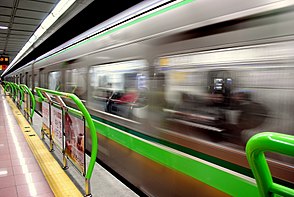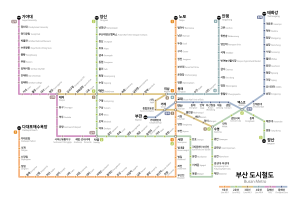Busan subway
| Busan Metro | |||
|---|---|---|---|
  | |||
| Info | |||
| Owner | City of Busan | ||
| Locale | Busan, South Korea | ||
| Transit type | Rapid transit, Commuter rail | ||
| Number of lines | 6 | ||
| Number of stations | 114 (metro only) 149 (incl. BGL, Donghae Line) | ||
| Daily ridership | 938,000 (2019, metro only) | ||
| Operation | |||
| Began operation | 19 July 1985 | ||
| Operator(s) | Busan Transportation Corporation B&G Metro Korail | ||
| Technical | |||
| System length | 116.5 km (72.4 mi) (metro only) 168.4 km (104.6 mi) (incl. BGL, Donghae Line) | ||
| Track gauge | 1,435 mm (4 ft 8 1⁄2 in) standard gauge[1] | ||
| |||
| Busan Metro | |
| Hangul | |
|---|---|
| Hanja | |
| Revised Romanization | Busan dosicheoldo |
| McCune–Reischauer | Pusan tosich'ŏlto |
The Busan Metro (Hangul: 부산 도시철도; Hanja: 釜山 都市鐵道; RR: Busan dosicheoldo) is a subway system in Busan, South Korea. Busan is one of four cities in South Korea with a subway system; the others are Seoul, Daegu and Incheon. Subway systems are also being built in Gwangju and Daejeon.[2] Planning for the Busan Subway began in 1979 and building started in 1981.[3] The first stage, a 16.2 km (10 mi) line with 17 stations between Nopo-dong and Beomnaegol opened on the 19 July 1985.[4] There are now 102 stations, four lines, and 106.8 km (66 mi) of tracks.
The system is operated by Busan Transportation Corporation. It was first launched in 1985 when Line 1 (Nopo-dong(노포동)~Beomnaegol(범내골)) was opened. Now there are 6 lines with 114 stations, 116.5 kilometers of tracks. Busan Transportation Corporation publishes a name of 'Humetro' as a brand identity.
Lines[change | change source]
| Operator | Line Name English |
Line Name Korean |
Starting Station | Ending Station | Stations[5] | Total Length[6] |
|---|---|---|---|---|---|---|
| Busan Transportation Corporation |
1호선 | Dadaepo Beach | Nopo | 40 | 40.5 km | |
| 2호선 | Jangsan | Yangsan | 43 | 45.2 km | ||
| 3호선 | Suyeong | Daejeo | 17 | 18.1 km | ||
| 4호선 | Minam | Anpyeong | 14 | 12.7 km | ||
| Subtotal | 114 | 116.5 km | ||||
| B&G Metro | 부산-김해 경전철 |
Sasang | Kaya University | 21 | 23.4 km | |
| 동해선 | Bujeon | Taehwagang | 23 | 65.7 km | ||
| Grand Total | 158 | 205.6 km | ||||
Line 1 (Orange Line)[change | change source]
Line 1 (Nopo-dong(노포동)~Beomnaegol(범내골)) was first opened in 1985. In 1994, the whole section (Nopo-dong(노포동)~Sinpyeong(신평)) was launched. Line 1 is the South-North route. And it passes right through the heart of the city. It was 32.5 km long with 34 stations in 1994 when the line was later extended to 40.5 km with 40 stations, which the extension was opened on April 20, 2017. The subway used in Line 1 is middle-sized subway. It was made of stainless domestically for the first time when being constructed. It is a 8-cars train. Many cutting edge technologies (including NATM, TBM construction methods) were used to construct line 1.
Line 2 (Green Line)[change | change source]
Line 2 (Hopo(호포)~Seo-myeon(서면)) first began operation in 1999, and the entire route (Jangsan(장산)~Hopo(호포)) was completed in 2002. Line 2 was built to solve chronic heavy traffic from east to west of the city. In 2008, the extension route (Hopo(호포)~Yangsan(양산)) was launched for developing transportation system between Busan and Yangsan city. The whole line 2 is 45.2 km in length, 43 stations. It is middle-sized subway and a 6-cars train. Shield construction method was used to build line 2. It was the first time to use this method when constructing the subway line in the country. This method was needed to build the line across Suyeong River.
Line 3 (Brown Line)[change | change source]
Line 3 (Suyeong(수영)~Daejeo(대저)) started its service in 2005. It is aimed at reducing traffic in Mandeok(만덕), Minam(미남) and Yeonsan-dong(연산동). Line 3 also connects relatively isolated Gangseo(강서) area with the center of the city. It is expected to help to improve the quality of life in Gangseo(강서) region. Line 3 is 18.1 km long with 17 stations. It is middle-sized subway and uses a 4-cars train. Line 3 subway is a Korean standard type train. All equipment is localized, and a train itself is 20% lighter than line 1 subway.
Line 4 (Blue Line)[change | change source]
Line 4 has been constructed since 2003. It opened on March 30, 2011. It connects from Minam(미남) to Anpyeong(안평) with 12 stations. The line’s length is 12.7 km. It is expected to promote development of Geumsa(금사), Bansong(반송) and Gijang(기장) regions. It is light rail which consumes only 80% money in construction and management compared to existing heavy rail.
Busan-Gimhae Light Rail Transit[change | change source]
This line is operated by Busan-Gimhae Light Rail Transit Corporation which (from Sasang(사상) to Gaya University) links to the western area of Busan to adjoining city of Gimhae. It has 21 stations and 23.9 km of track. It was completed and opened on September 9, 2011.
Passenger[change | change source]
The number of passengers using Busan subway is about 263,574,000 a year (2009. It means that average 722,000 people use Busan subway everyday. Among them, 401,000 people use line 1, 250,000 people line 2, and 71,000 people line 3.[7]
Related pages[change | change source]
References[change | change source]
- ↑ "B&G Metro - Introduction - Light Rail Vehicles". Archived from the original on 2014-12-08. Retrieved 2018-02-03.
- ↑ "Public Transportation in Korea – Airports, Subways, Trains". gone2korea.com. 2011. Archived from the original on 31 December 2011. Retrieved 4 January 2012.
- ↑ "Busan Transportation Corporation: History". subway.busan.kr. 2012. Archived from the original on 6 October 2011. Retrieved 4 January 2012.
- ↑ "Busan (Pusan) Metro". urbanrail.net. 2011. Archived from the original on 19 May 2006. Retrieved 4 January 2012.
- ↑ "Route Map > Integrated Route Map". Busan Transportation Corporation. Retrieved 2014-08-11.
- ↑ "Introduction > History". Busan Transportation Corporation. 2011. Retrieved 2014-08-11.
- ↑ "경영성과".
Other websites[change | change source]
- Busan Transportation Corporation – official website (in English)
- M&G Metro Corporation – official website Archived 2012-03-28 at the Wayback Machine (in English)
- Busan Subway Transit Search Archived 2016-03-03 at the Wayback Machine(in English)

